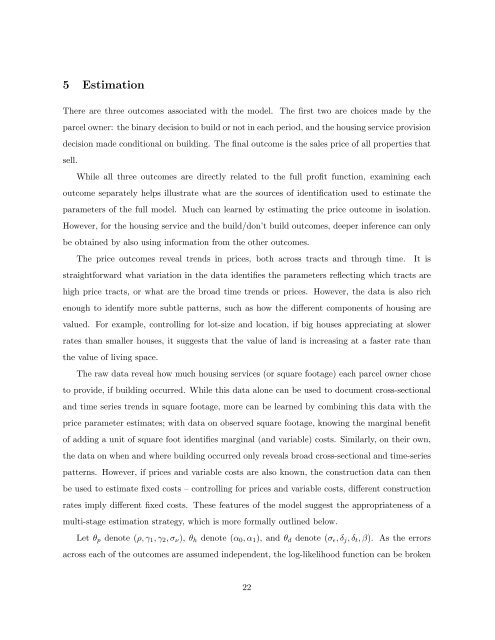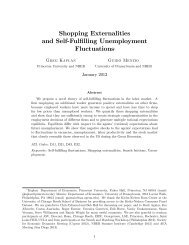A Dynamic Model of Housing Supply
A Dynamic Model of Housing Supply
A Dynamic Model of Housing Supply
Create successful ePaper yourself
Turn your PDF publications into a flip-book with our unique Google optimized e-Paper software.
5 EstimationThere are three outcomes associated with the model. The first two are choices made by theparcel owner: the binary decision to build or not in each period, and the housing service provisiondecision made conditional on building. The final outcome is the sales price <strong>of</strong> all properties thatsell.While all three outcomes are directly related to the full pr<strong>of</strong>it function, examining eachoutcome separately helps illustrate what are the sources <strong>of</strong> identification used to estimate theparameters <strong>of</strong> the full model. Much can learned by estimating the price outcome in isolation.However, for the housing service and the build/don’t build outcomes, deeper inference can onlybe obtained by also using information from the other outcomes.The price outcomes reveal trends in prices, both across tracts and through time. It isstraightforward what variation in the data identifies the parameters reflecting which tracts arehigh price tracts, or what are the broad time trends or prices. However, the data is also richenough to identify more subtle patterns, such as how the different components <strong>of</strong> housing arevalued. For example, controlling for lot-size and location, if big houses appreciating at slowerrates than smaller houses, it suggests that the value <strong>of</strong> land is increasing at a faster rate thanthe value <strong>of</strong> living space.The raw data reveal how much housing services (or square footage) each parcel owner choseto provide, if building occurred. While this data alone can be used to document cross-sectionaland time series trends in square footage, more can be learned by combining this data with theprice parameter estimates; with data on observed square footage, knowing the marginal benefit<strong>of</strong> adding a unit <strong>of</strong> square foot identifies marginal (and variable) costs. Similarly, on their own,the data on when and where building occurred only reveals broad cross-sectional and time-seriespatterns. However, if prices and variable costs are also known, the construction data can thenbe used to estimate fixed costs – controlling for prices and variable costs, different constructionrates imply different fixed costs. These features <strong>of</strong> the model suggest the appropriateness <strong>of</strong> amulti-stage estimation strategy, which is more formally outlined below.Let θ p denote (ρ, γ 1 , γ 2 , σ ν ), θ h denote (α 0 , α 1 ), and θ d denote (σ ɛ , δ j , δ t , β). As the errorsacross each <strong>of</strong> the outcomes are assumed independent, the log-likelihood function can be broken22
















